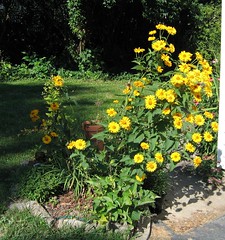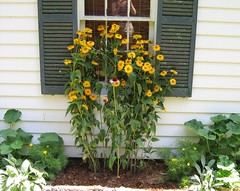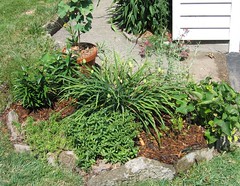Transplanting in July
 Looking at my yard on Sunday, I had two problem areas. The first, was the wedge shaped bed near the garage. I was thrilled with it in the spring. The snowdrops, creeping phlox, and forget-me-nots were blooming. The emerging mint had a purple cast and filled in the bed nicely. I was enjoying the lovely foliage of my newly planted Stella D’Oro. As the season progressed, I was less happy with the plantings. The mint began smothering the other plants, so I ripped it out, leaving a number of bare spots. The clematis I had transplanted from the destruction zone became unhappy and almost too large for the small bed. When the Stella and the coreopsis bloomed, the two shades of yellow clashed horribly. The coreopsis and a single coneflower grew to five feet tall and flopped over the walkway. They completely overwhelmed the petite space.
Looking at my yard on Sunday, I had two problem areas. The first, was the wedge shaped bed near the garage. I was thrilled with it in the spring. The snowdrops, creeping phlox, and forget-me-nots were blooming. The emerging mint had a purple cast and filled in the bed nicely. I was enjoying the lovely foliage of my newly planted Stella D’Oro. As the season progressed, I was less happy with the plantings. The mint began smothering the other plants, so I ripped it out, leaving a number of bare spots. The clematis I had transplanted from the destruction zone became unhappy and almost too large for the small bed. When the Stella and the coreopsis bloomed, the two shades of yellow clashed horribly. The coreopsis and a single coneflower grew to five feet tall and flopped over the walkway. They completely overwhelmed the petite space.The second ugly spot was the garage bed. Again, I was happy with it in the spring. I tucked a number of miscellaneous plants from Patrick into the narrow space and was happy with the contrasting foliage. Later, I added a few hollyhocks to the mix. I was trying to grow perennial poppies in the center of the bed, beneath the window, but had only succeeded in raising giant weeds. Then, a few weeks ago, my neighbor asked me if I was growing vegetables along the garage. I regarded the bed and realized that it DID look like a vegetable garden. Almost nothing was in bloom. The hollyhocks, in their first season, look like squash plants. The bed was a sea of green leaves without even the promise of a fresh salad.
By Sunday morning, I had some sale plants from Moeller’s and Home Depot and an itch to do some transplanting. My plan was to move the coreopsis to the poppies’ former seed bed along the garage, dig up the clematis, and fill in the bare spots in the wedge bed with my new purchases.
First, I prepared the coreopsis’ new home. I dug a nice big trench in the light soil along the garage wall. As is Mr. Tibbs’ wont, he climbed in to provide some liquid fertilizer. After ejecting the kitten, I followed the summer-time transplant advice given on Perennial Passion, and filled the hole twice with water. After the second filling, I wandered off to find some gardening tool. When I returned, the water had soaked into the ground and Mr. Tibbs had provided more fertilizer – in the solid form this time. Kitties can be troublesome garden helpers.
I dug the coreopsis, coneflower, and larkspur out of the wedge bed and soaked the roots in vats of water. I removed the clematis with a large clump of soil and dropped it into a temporary pot, trying to disturb its roots as little as possible. I then combed through the dirt to remove fistfuls of mint roots. They had so thoroughly invaded the soil that I could understand why my coreopsis needed such frequent watering.
 I divided the coreopsis into two bunches and planted it, along with the single coneflower, under (or, rather, in front of) the garage window. I’m hoping that the structure will hold the lanky blooms aloft and that, with the competition from mint roots gone, the plants will grow more extensive and supportive root systems. I need to add some shorter plants in front to disguise the legs, but the bright blooms instantly improved my “vegetable” bed.
I divided the coreopsis into two bunches and planted it, along with the single coneflower, under (or, rather, in front of) the garage window. I’m hoping that the structure will hold the lanky blooms aloft and that, with the competition from mint roots gone, the plants will grow more extensive and supportive root systems. I need to add some shorter plants in front to disguise the legs, but the bright blooms instantly improved my “vegetable” bed. In the wedge bed, I planted two Russian sage where the coreopsis and coneflower had been. I repositioned the larkspur and added two orange pixie lilies and a coreopsis “limerock ruby” (tickseed). (I’ve probably stuffed too much into the bed, but I can always move it!) Click on the photo for a labeled version.
In the wedge bed, I planted two Russian sage where the coreopsis and coneflower had been. I repositioned the larkspur and added two orange pixie lilies and a coreopsis “limerock ruby” (tickseed). (I’ve probably stuffed too much into the bed, but I can always move it!) Click on the photo for a labeled version.The clematis is cooling its heels in a pot positioned in its new location. I will probably put it in the ground during my planned fall planting fest. (I’ve got hostas, gardenia, jasmine, mock oranges, hydrangeas, and a dogwood to plant.)
Five days later, the transplants are doing well. The tall coreopsis and coneflower had a rough time at first, probably due to their stunted root systems, but with consistent watering for the first two days and the more recent rain and cool weather, they’ve perked up. I’m glad I moved the plants around. I’m no longer driven bonkers by the leaning flowers, I found a home for my sale plants (except one orphaned Russian sage), and I’ve lost my fear of transplanting in July.


8 Comments:
lookin' fan-tas-tic!
my neighbour is constantly moving things around in her garden- in every season! surprisingly all her plants do really well, too!
I am always having to move and adjust. As plants mature, they get bigger and certain ones dominate. I need to divide some bulbs as well, and expand my beds for the expanding plants! It's like adding paint to a canvas kind of- it can go on a while. Nice work there!
Good to hear the transplanting went well. I always worry that I'll move the plant at the wrong time. You can be my inspiration and I'll just try to keep the plants happy and healthy during their move. The garden is looking great!
I've heard you have to be careful with mints, that they have a tendency to take over. At a gardening class this spring, a woman was complaining about coneflowers taking over her yard, so your single one should expand with no trouble to fill in the space. Everything looks great!
Looking good. You did a great job moving such a large plant and not having is sprawling all over the ground!
I so agree with Zoey!
If you want to grow plants that are invasive, you can put a large planter in the ground and grow them in that. It looks like it is just another plant in the garden but can't spread by root.
Keep an eye on the Russian sage, it took over the back garden behind our house. It's not as agressive as mint, but it's not completely innocent either.
This comment has been removed by a blog administrator.
Post a Comment
<< Home